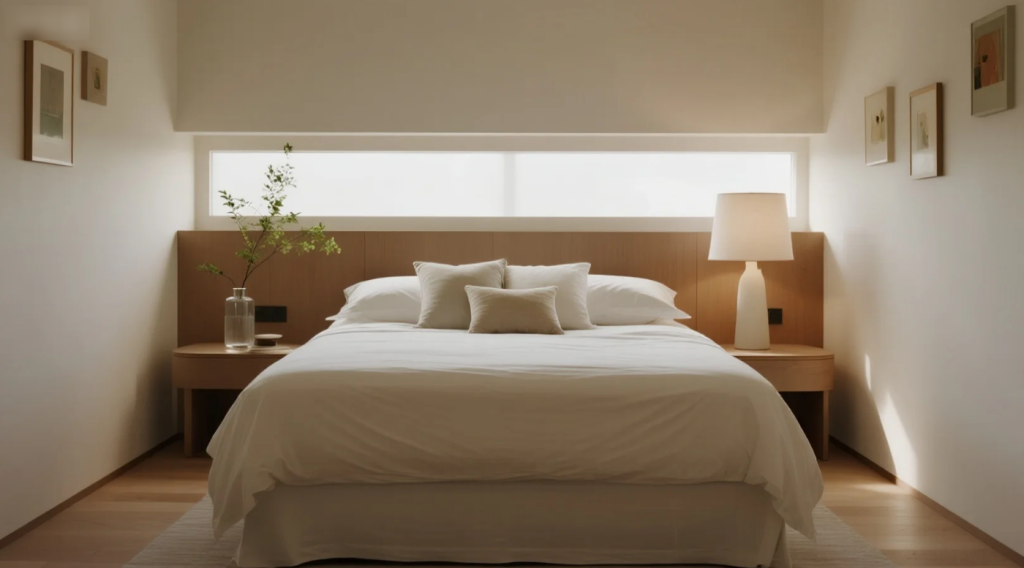Have you ever stepped into a home that just feels right — where everything flows harmoniously, and the decor has a rhythm that draws you in?

That sense of balance and visual symmetry may not be accidental. Even if the homeowner isn’t consciously following Feng Shui principles, there’s a good chance they’re tapping into one of its core design philosophies: the Rule of Three.
While often discussed in interior design circles as a simple visual strategy, this principle holds much deeper energetic meaning in Feng Shui. We spoke with house therapist and Feng Shui specialist Amy Babish to uncover how this concept works — and how you can apply it with intention to shift the energy in your own space.
What Is the Feng Shui Rule of Three?
At its core, the Rule of Three in Feng Shui goes beyond a styling trick. It’s a symbolic and energetic framework rooted in balance, movement, and transformation.
“In Feng Shui, the Rule of Three reflects the interplay between rhythm, balance, and energetics,” explains Babish. “It represents three forces or elements working in harmony to create momentum and a sense of completion.”
This triadic relationship isn’t just found in design — it echoes the natural order of things. In Taoist philosophy, for example, the Cosmic Trinity (Heaven, Earth, and Humanity) represents the structure of all creation. In design terms, we often see this expressed in groupings of three objects — vases, candles, cushions — but its significance runs much deeper in Feng Shui.
How to Use the Rule of Three in Your Home’s Energy Design
Using the Rule of Three in Feng Shui doesn’t require a redesign. It’s about curating intentional groupings that combine energetic compatibility and visual appeal.
💡 Practical Ways to Apply It:
- Decorate with three of the same element, such as plants in wooden pots or three framed botanical prints. Amy explains that the wood element is especially compatible with this principle, representing growth and vitality.
- Combine different elements in trios to stimulate energy flow and initiate change. Try wood (for growth), metal (for precision), and water (for emotional movement) grouped thoughtfully in a shared space.
“When you bring together three harmonized elements, you activate transformation,” says Babish. “This can be particularly useful in areas where there’s energetic stagnation — whether in relationships, work, or personal development.”
What matters most is intention. Rather than randomly placing three items for style’s sake, think about what you’re trying to invite — is it more harmony, clarity, creativity, or momentum?
Why the Number 3 Is So Powerful in Feng Shui
In Feng Shui numerology, the number three is symbolic of new beginnings and expansion. It’s associated with springtime — when plants break through the soil and reach toward the light.
“Three represents the synthesis of dual forces,” says Amy. “When two energies meet, a third is born — that’s the essence of transformation. In Feng Shui, that’s how qi (energy) evolves.”
This symbolism is reflected in the physical world, emotional states, and even business growth. Whether you’re cultivating creativity in your home office or nurturing connection in your living room, using the number three strategically can enhance the purpose of a space.
But Babish also offers a word of caution: overusing the Rule of Three without mindfulness can lead to unsettled energy. “If applied mechanically or excessively, it can create restlessness. Use it with awareness, and your space becomes an active collaborator in your life.”
FAQs
What Does the Number 3 Symbolize in Feng Shui?
In Feng Shui, the number 3 represents growth, movement, and forward momentum. It’s linked to the wood element and the energy of spring, symbolizing new life and upward expansion. On a deeper level, it reflects the alchemical union of two forces to produce a transformative third.
Can the Rule of Three Be Used in Every Room?
Yes — but intentionally. Whether you’re decorating a bedroom, workspace, or entryway, groupings of three can be used to create visual rhythm and energetic harmony. Just ensure that the items you group together share either a purpose, element, or aesthetic — and that their energy supports the function of the space.
Is the Rule of Three Only About Decor?
Not at all. While it’s often seen in visual design, the Rule of Three in Feng Shui is more about energy configuration. It’s used to enhance balance, shift stagnation, and create flow. Whether it’s through three meaningful objects, elemental harmony, or a trio of intentions (like love, health, and prosperity), the impact goes beyond appearance.
Final Thoughts: Let Your Space Reflect Your Intentions
The Rule of Three in Feng Shui invites you to move beyond decoration and into co-creation. When used consciously, it helps transform your home from a collection of furniture into a supportive environment aligned with your goals, emotions, and personal growth.
Start small: group three objects with shared meaning, align your space with your intentions, and see how the energy shifts.
Your home isn’t just where you live — it’s where your energy lives, too.
Optional Add-ons for SEO Boost (Let Me Know if You Want These Included)
- Meta Title (within 60 characters): Feng Shui’s Rule of Three: A Powerful Design Principle
- Meta Description (within 160 characters): Discover how Feng Shui’s Rule of Three can shift energy, boost balance, and enhance your home with intention — expert-backed insights included.
- Schema FAQ Markup for structured search results
- Suggested internal links to Feng Shui room layout tips, color guides, or decluttering methods
- Optimized H1/H2 tags for semantic clarity and keyword spread
